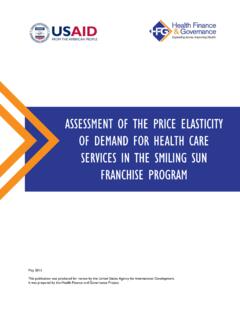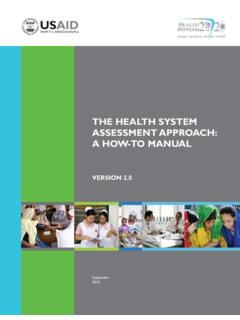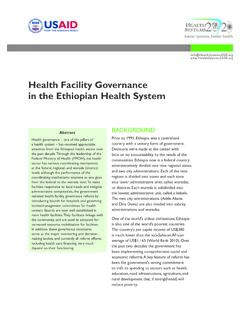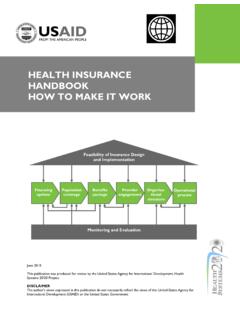Transcription of Health Care Financing Reform in Ethiopia: Improving ...
1 I n fo @ H e a l t h S y s t e m s 2 0 2 0 . o r g w w w. H e a l t h S y s t e m s 2 0 2 0 . o r gbetter systems, better healthBackgroundHealtH StatuSEthiopia is situated in the northeastern segment of the african continent, commonly known as the Horn of africa, with a land mass of million square kilometers. With a total population of more than million in 2007, Ethiopia is the third most populous country in africa, following nigeria and than 44 percent of the population is under the age of 15 years, and over half (52 percent) of the population is in the age range of 15 to 65 years. Preventable communicable diseases and nutritional disorders continue to be major Health issues.
2 The most recent vital Health indicators (2007/08) show a life expectancy of 54 years ( years for male and for female), an infant mortality rate of 77/1000, and an under-five mortality rate of 123/1000. More than 90 percent of child deaths are due to pneumonia, diarrhea, malaria, neonatal problems, malnutrition, and HIV/aIdS, and often to a combination of these. The maternal mortality rate, at 673/100,000 (cSa et al. 2006), remains high. The major causes of maternal death are primarily pregnancy related and preventable: obstructed/prolonged labor (13 percent), ruptured uterus (12 percent), and severe pre-eclampsia/eclampsia (11 percent). Health care Financing Reform in Ethiopia: Improving Quality and EquityAbstractEthiopia endorsed a Health care Financing strategy in 1998 that envisioned a wide range of Reform initiatives.
3 The implementation of these Reform initiatives was legalized through regional legislations and operationalized in line with prototype implementation frameworks that were modified and aligned within specific regional contexts. In 2004, actual implementation was initiated in amhara, oromia, and Southern nations, nationalities, and People (SnnP) regional States following ratification and endorsement of regional proclamations, regulations, and directives by the respective regional councils (Parliaments), regional executive councils (cabinets), and regional Health Bureaus (rHBs). currently, the reforms have expanded to the remaining regions, with the exception of afar and Somali, which are still in the process of endorsing legal and operational frameworks.
4 All other regions (Tigray, Benshangul-gumuz, gambella, Harari, addis ababa, and dire dawa) have already begun implementation. The strategy recognized that Health care should be financed through multiple Financing mechanisms to ensure long-range sustainability. The reforms introduced include implementing revenue retention and use at Health facility level, systematizing a fee-waiver system for the poor, standardizing exemption services, setting and revising user fees, introducing a private wing in public hospitals, outsourcing nonclinical services, and promoting Health facility autonomy through the introduction of a governance system. The purpose of this background paper is to provide a glimpse of these reforms, the major progress and achievements made through their implementation, and the role of uSaId s continued technical and financial support in implementation of these reforms and related HealthSystems20/20 Six percent of all maternal deaths were attributable to complications from abortion.
5 Malaria accounts for 9 percent of deaths. Shortages of skilled midwives, a weak referral system at Health center levels, inadequate availability of basic emergency obstetric care and comprehensive emergency obstetric care equipment, and under- Financing of key services were identified as major supply-side constraints that have hindered progress (FMoH 2010a). Recent Health SyStem StRuctuRal cHangeSEthiopia recently introduced a three-tier Health care delivery system. Level one: The woreda (district) includes a primary hospital (with population coverage of 100,000 people), Health centers (1/25,000 population), and their satellite Health posts (1/5,000 population) connected to each other by a referral system.
6 Health centers and Health posts form a primary Health care unit with each Health center having five satellite Health posts. Level two: a general hospital with population coverage of 1 million three: a specialized hospital that covers a population of 5 million. The rapid expansion of the private-for-profit and nongovernmental organization (NGO) sectors is playing a significant role in expanding Health service coverage and utilization of the Ethiopian Health care System, thus enhancing the public/private/ngo partnerships in the delivery of Health care services in the at different levels of the Health sector, from the Federal Ministry of Health (FMoH) to rHBs and woreda Health offices, share decision-making processes, powers, and duties where FMoH and the rHBs focus more on policy matters and technical support while woreda Health offices focus on managing and coordinating the operation of a district Health system that includes a primary hospital, Health centers, and Health posts under the woreda s and districts have rHBs and district Health offices to manage public Health services at their levels.
7 The devolution of power to regional governments has resulted in a shift of public service delivery, including Health care , largely under the authority of the Health Financing iSSueS The World Health Report of 2010 identified three interrelated problems that limit universal coverage: (1) limited availability of Health resources, (2) over-reliance on direct payments at the time people need care , and (3) inefficient and inequitable use of resources (WHo 2010). The limited availability of resources for Health in Ethiopia is very clear. The total Health spending in Ethiopia increased from about uS$522 million in 2004/05 to about uS$ billion in 2007/08. However, overall Health is under-financed, both in absolute terms and when compared to the sub-Saharan africa average, as evidenced by per capita Health spending of uS$ in 1995/96 (FMoH 2001) that reached only in 2007/08 (FMoH 2007).
8 On the demand side, cultural norms, distance to functioning Health centers, and financial barriers were found to be the major causes for not seeking Health services in Health facilities (FMoH 2011).The FMOH of Ethiopia developed a Health care Financing strategy in 1998 that was endorsed by the council of Ministers and became a very important policy document for introduction of Health Financing reforms. The government recognized that Health cannot be financed only by government and underscored the importance of promoting cost sharing in provision of Health services. 3 HealthSystems20/20 WHy Health Financing Reform In ETHIoPIa?In the early 1990s, Ethiopia was recovering from a prolonged civil war, the Health infrastructure had seriously deteriorated, and the Health service system was dysfunctional.
9 Physical access to Health service providers was beyond the reach of the majority of the Ethiopian population, and even more difficult for the poorest segments of the population. The overall country budget was limited, resulting in inadequate Financing of Health care . In addition, Health service delivery was inefficient and inequitable, and quality of Health care was generally poor. For instance, in the 1995/96 Ethiopian Fiscal year (EFy), the annual per capita spending on Health in Ethiopia was only uS$ too small an amount to buy good basic Health services (FMoH 2001). The round-four national Health account (nHa) reports revealed that per capita spending on Health is steadily growing (see Figure 1).
10 As stated, in EFy 1995/96, per capita spending on Health was only uS$ , but increased steadily to uS$ , uS$ , and uS$ in 1999/2000, 2004/05, and 2007/08, respectively. However, even at the relatively high level of current spending, spending on Health is still far from adequate to buy good Health those areas where limited human resources were available, diagnostic equipment was not functioning and essential drugs were not available, compromising quality of Health care . a willingness-and-ability-to-pay study conducted in 2001 revealed that respondents found the services provided by public clinics and Health centers and hospitals unsatisfactory and below average (30 percent and 47 percent, respectively).







